Marc Chaumont
Automatic coral reef fish identification and 3D measurement in the wild
Dec 12, 2023



Abstract:In this paper we present a pipeline using stereo images in order to automatically identify, track in 3D fish, and measure fish population.
Astronomical image time series classification using CONVolutional attENTION (ConvEntion)
Apr 03, 2023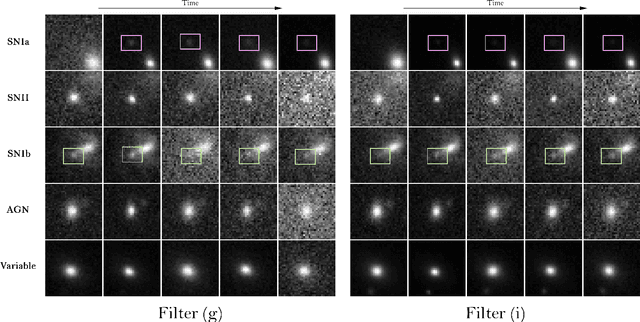
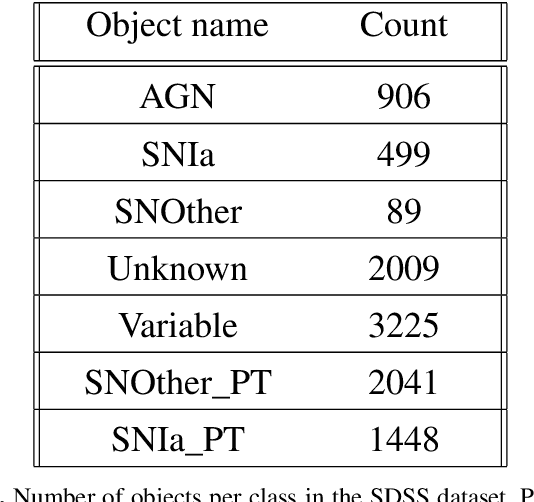
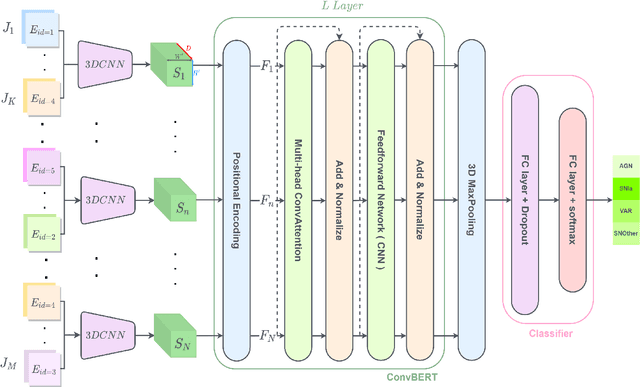
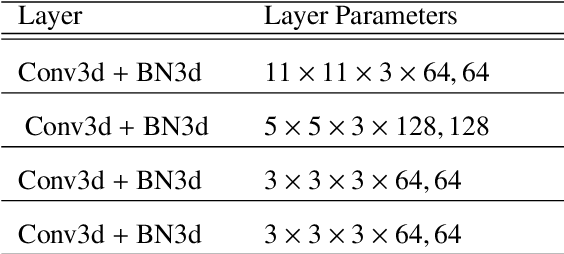
Abstract:Aims. The treatment of astronomical image time series has won increasing attention in recent years. Indeed, numerous surveys following up on transient objects are in progress or under construction, such as the Vera Rubin Observatory Legacy Survey for Space and Time (LSST), which is poised to produce huge amounts of these time series. The associated scientific topics are extensive, ranging from the study of objects in our galaxy to the observation of the most distant supernovae for measuring the expansion of the universe. With such a large amount of data available, the need for robust automatic tools to detect and classify celestial objects is growing steadily. Methods. This study is based on the assumption that astronomical images contain more information than light curves. In this paper, we propose a novel approach based on deep learning for classifying different types of space objects directly using images. We named our approach ConvEntion, which stands for CONVolutional attENTION. It is based on convolutions and transformers, which are new approaches for the treatment of astronomical image time series. Our solution integrates spatio-temporal features and can be applied to various types of image datasets with any number of bands. Results. In this work, we solved various problems the datasets tend to suffer from and we present new results for classifications using astronomical image time series with an increase in accuracy of 13%, compared to state-of-the-art approaches that use image time series, and a 12% increase, compared to approaches that use light curves.
A study on the invariance in security whatever the dimension of images for the steganalysis by deep-learning
Feb 22, 2023



Abstract:In this paper, we study the performance invariance of convolutional neural networks when confronted with variable image sizes in the context of a more "wild steganalysis". First, we propose two algorithms and definitions for a fine experimental protocol with datasets owning "similar difficulty" and "similar security". The "smart crop 2" algorithm allows the introduction of the Nearly Nested Image Datasets (NNID) that ensure "a similar difficulty" between various datasets, and a dichotomous research algorithm allows a "similar security". Second, we show that invariance does not exist in state-of-the-art architectures. We also exhibit a difference in behavior depending on whether we test on images larger or smaller than the training images. Finally, based on the experiments, we propose to use the dilated convolution which leads to an improvement of a state-of-the-art architecture.
A CNN adapted to time series for the classification of Supernovae
Jan 02, 2019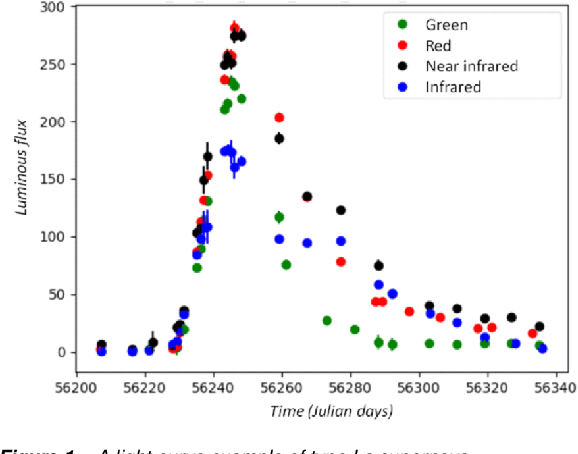



Abstract:Cosmologists are facing the problem of the analysis of a huge quantity of data when observing the sky. The methods used in cosmology are, for the most of them, relying on astrophysical models, and thus, for the classification, they usually use a machine learning approach in two-steps, which consists in, first, extracting features, and second, using a classifier. In this paper, we are specifically studying the supernovae phenomenon and especially the binary classification "I.a supernovae versus not-I.a supernovae". We present two Convolutional Neural Networks (CNNs) defeating the current state-of-the-art. The first one is adapted to time series and thus to the treatment of supernovae light-curves. The second one is based on a Siamese CNN and is suited to the nature of data, i.e. their sparsity and their weak quantity (small learning database).
Yedrouj-Net: An efficient CNN for spatial steganalysis
Feb 26, 2018



Abstract:For about 10 years, detecting the presence of a secret message hidden in an image was performed with an Ensemble Classifier trained with Rich features. In recent years, studies such as Xu et al. have indicated that well-designed convolutional Neural Networks (CNN) can achieve comparable performance to the two-step machine learning approaches. In this paper, we propose a CNN that outperforms the state-ofthe-art in terms of error probability. The proposition is in the continuity of what has been recently proposed and it is a clever fusion of important bricks used in various papers. Among the essential parts of the CNN, one can cite the use of a pre-processing filterbank and a Truncation activation function, five convolutional layers with a Batch Normalization associated with a Scale Layer, as well as the use of a sufficiently sized fully connected section. An augmented database has also been used to improve the training of the CNN. Our CNN was experimentally evaluated against S-UNIWARD and WOW embedding algorithms and its performances were compared with those of three other methods: an Ensemble Classifier plus a Rich Model, and two other CNN steganalyzers.
* ICASSP'2018, 15-20 April 2018, Calgary, Alberta, Canada, 5 pages
How to augment a small learning set for improving the performances of a CNN-based steganalyzer?
Feb 03, 2018



Abstract:Deep learning and convolutional neural networks (CNN) have been intensively used in many image processing topics during last years. As far as steganalysis is concerned, the use of CNN allows reaching the state-of-the-art results. The performances of such networks often rely on the size of their learning database. An obvious preliminary assumption could be considering that "the bigger a database is, the better the results are". However, it appears that cautions have to be taken when increasing the database size if one desire to improve the classification accuracy i.e. enhance the steganalysis efficiency. To our knowledge, no study has been performed on the enrichment impact of a learning database on the steganalysis performance. What kind of images can be added to the initial learning set? What are the sensitive criteria: the camera models used for acquiring the images, the treatments applied to the images, the cameras proportions in the database, etc? This article continues the work carried out in a previous paper, and explores the ways to improve the performances of CNN. It aims at studying the effects of "base augmentation" on the performance of steganalysis using a CNN. We present the results of this study using various experimental protocols and various databases to define the good practices in base augmentation for steganalysis.
Deep learning is a good steganalysis tool when embedding key is reused for different images, even if there is a cover source-mismatch
Jan 12, 2018

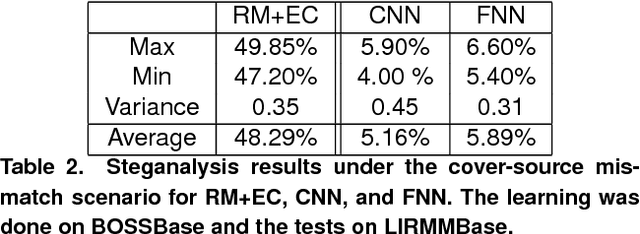
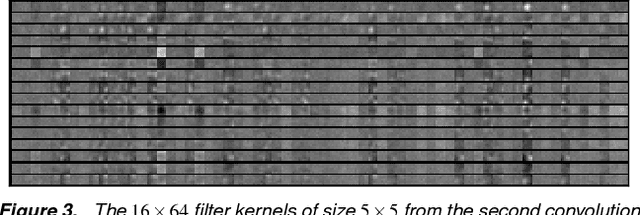
Abstract:Since the BOSS competition, in 2010, most steganalysis approaches use a learning methodology involving two steps: feature extraction, such as the Rich Models (RM), for the image representation, and use of the Ensemble Classifier (EC) for the learning step. In 2015, Qian et al. have shown that the use of a deep learning approach that jointly learns and computes the features, is very promising for the steganalysis. In this paper, we follow-up the study of Qian et al., and show that, due to intrinsic joint minimization, the results obtained from a Convolutional Neural Network (CNN) or a Fully Connected Neural Network (FNN), if well parameterized, surpass the conventional use of a RM with an EC. First, numerous experiments were conducted in order to find the best " shape " of the CNN. Second, experiments were carried out in the clairvoyant scenario in order to compare the CNN and FNN to an RM with an EC. The results show more than 16% reduction in the classification error with our CNN or FNN. Third, experiments were also performed in a cover-source mismatch setting. The results show that the CNN and FNN are naturally robust to the mismatch problem. In Addition to the experiments, we provide discussions on the internal mechanisms of a CNN, and weave links with some previously stated ideas, in order to understand the impressive results we obtained.
 Add to Chrome
Add to Chrome Add to Firefox
Add to Firefox Add to Edge
Add to Edge